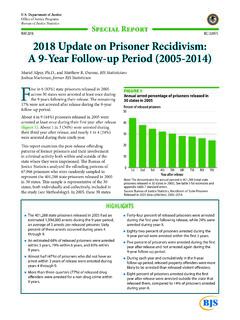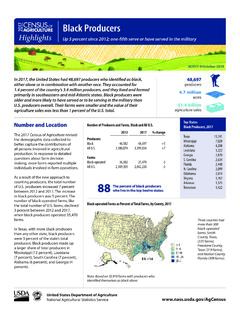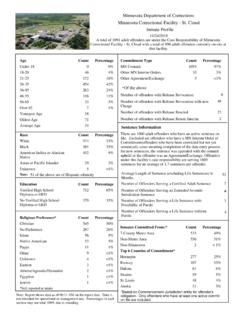Transcription of Lifetime Likelihood of Going to State or Federal Prison
1 By Thomas P. Bonczarand Allen J. Beck, StatisticiansAn estimated of all persons inthe United States will be confined in aState or Federal Prison during theirlifetime, if incarceration rates recordedin 1991 remain unchanged in the fu-ture. The Lifetime chances of a persongoing to Prison are higher for men( ) than for women ( ) andhigher for blacks ( ) and Hispan-ics ( ) than for whites ( ). Atcurrent levels of incarceration a blackmale in the United States today hasgreater than a 1 in 4 chance of goingto Prison during his Lifetime , while aHispanic male has a 1 in 6 chance anda white male has a 1 in 23 chance ofserving Lifetime Likelihood of incarceration,the focus of this study, represents thepercentage of all residents ex-pected to be incarcerated in a Prison atsome time in life.
2 Such a measure ishypothetical based on the assump-tion that recent rates of incarceration(and death rates) will not change in thefuture. Unlike a standard incarcerationrate, which expresses the prevalenceof incarceration on a single day, thelifetime Likelihood measure summa-rizes the chances of a person being incarcerated at some time over an entire Lifetime . Bureau of Justice StatisticsSpecial Report If recent incarceration rates remainunchanged, an estimated 1 of every20 persons ( ) will serve time ina Prison during their Lifetime . Men ( ) are over 8 times morelikely than women ( ) to be in-carcerated in Prison at least onceduring their life. Among men, blacks ( ) areabout twice as likely as Hispanics( ) and 6 times more likely thanwhites ( ) to be admitted toprison during their life.
3 Among women, of blacks, of Hispanics, and ofwhites will enter Prison at least once. The chance of Going to Prison forthe first time declines with age Chance of Going to Prison during Not yet rest of life incarceratedAllWhiteBlackby age personsmenmen Birth .9 Nearly two-thirds of those admittedto Prison for the first time will havebeen on probation and a third willhave served a sentence to a localjail or juvenile Department of JusticeOffice of Justice ProgramsLifetime Likelihood of Goingto State or Federal Prison 0%10%20%30%Hispanic1320304050607080 Age at first admissionCumulative percent of males malesPercentage of males likely to ever go to Prison ,based on constant 1991 rates of first incarceration, by age, race, and Hispanic origin 1997, NCJ-160092 The chances of Going to Prison , by sex, race, and Hispanic originLife table procedures have been re-peated for males and females, whites,blacks.
4 And Hispanics subgroupswith different rates of death and firstincarceration. Estimates coming fromthese procedures summarize the com-bined impact of the differential rates. Overall, an estimated of all per-sons in the United States will servetime in a State or Federal Prison duringtheir Lifetime , if recent rates of first in-carceration and mortality remain un-changed (table 1). Men are over 8 times more likely thanwomen to be incarcerated in Prison atleast once during their Lifetime . A malehas a (or 1 in 11) chance in hislifetime of Going to Prison , while a fe-male has a (or 1 in 91) chance. Blacks in the resident population( ), regardless of their sex, arenearly twice as likely as Hispanics( ) and 6 times more likely thanwhites ( ) to be admitted to prisonduring their lives.
5 Among men, more than 1 in 4 blacks and 1 in 6 Hispanics, compared to 1 in23 whites, will enter Prison at leastonce if current first-incarceration rates2 Lifetime Likelihood of Going to State or Federal PrisonTable 1. Chances of Going to State or Federal Prison for the first time, by age, sex, race, and Hispanic origin Cumulative percent of resident population expected to go to State or Federal Prison for the first time, by age .1 .3 .6 .8 . originWhite* .4% . 0 .2 .3 .4 .4 .5 .5 .5 .5 .5 black * . Female .1 .4 .7 . : The cumulative percents represent the chances of being admitted to State or Federal Prison for the first time, by age.
6 Estimateswere obtained by sequentially applying age-specific first-incarceration rates and mortality rates for each group to a hypo-thetical population of 100,000 births. (See Methodology, page 8.) *Excludes persons of Hispanic life experiencesbased on annual ratesEstimates of the Lifetime Likelihood of Going to Prison are derived fromstandard life table techniques used by demographers and actuaries tosummarize observed rates and to project them into the future. Whenapplied to the study of the prisonpopulation, the Lifetime estimates rep-resent the combined experience offirst admission to Prison and mortalityby age of the resident populationduring a 12-month period.
7 The estimates do not reflect the expe-rience of any actual group but ratherof a hypothetical group that is subjectto a fixed set of age-specific rates offirst incarceration and mortality. Assuch, the estimates depict the pro-jected mortality and incarceration ex-perience of newborn residents,assuming that the mortality and incar-ceration rates observed during a12-month period remain unchanged inthe future. ( See Methodology, page8.)Life table techniques have been ap-plied in numerous fields to summarizethe Likelihood that an event may oc-cur. The following four examples uselifetime rates to express statisticsabout familiar life events: 5 out of 6 persons are expected tobe a victim of an attempted or com-pleted violent crime (rape, robbery,and assault, excluding murder) atleast once during life, based on1975-84 annual victimization rates.
8 (See Lifetime Likelihood of Victimiza-tion, BJS, NCJ-10427, March 1987.) 1 of every 100 men and of every323 women are expected to be a vic-tim of murder, based on 1978-80 an-nual murder rates and lifetimeprobabilities. (See Crime in theUnited States, 1981, FBI.) of all new marriages are expected to end in divorce, based on marriage and divorce statistics for 1976-77. (See National Estimatesof Marriage Dissolution and Survivor -ship: United States, National Centerfor Health Statistics, November1980.) 1 of every 8 American women areprojected to develop breast cancer in their Lifetime , if 1987-88 rates re-main unchanged. (See The LifetimeRisk of Developing Breast Cancer,Journal of the National Cancer Insti-tute, June 1993.)
9 Do not change. An estimated of black men, of Hispanic men,and of white men are expected to serve a State or Federal general, women have lower lifetimechances of incarceration than men;however, black women ( ) havenearly the same chance as white men( ) of serving time in women, blacks are more thantwice as likely as Hispanics ( ) and7 times more likely than whites ( )to be admitted to Prison during Likelihood of Going to Prison ,by ageIn addition to permitting calculation ofthe Lifetime chances of incarceration,the same life table techniques produceestimates of the Likelihood of incarcer-ation for persons at specific the rates of first incarceration andmortality recorded in 1991 remain unchanged, an estimated of allpersons born today will go to Prison by the time they are age 20; by the time they are 30.
10 And by the time they are every age, men have higherchances of Going to Prison thanwomen, and blacks and Hispanicshave higher chances than on current rates of first incar-ceration, an estimated of blackmales will enter State or Federal prisonby the time they are age 20, comparedto of Hispanic males and ofwhite percentages double in the next 5years of life and then begin to increasemore slowly: By age 25, of black males, of Hispanic males, and of white males are expected to haveserved some time in State or Federalprison. By age 30 of black males, of Hispanic males, and of white males By age 35 of black males, of Hispanic males, and white males By age 40 of black males, of Hispanic males, and white males will have served chances of Going to Prison decline with advancing ageThe life table calculations also provideestimates of the Likelihood of Going toprison at some time during the rest oflife among persons not previously Lifetime Likelihood of Going to State or Federal Prison 3 Table 2.















